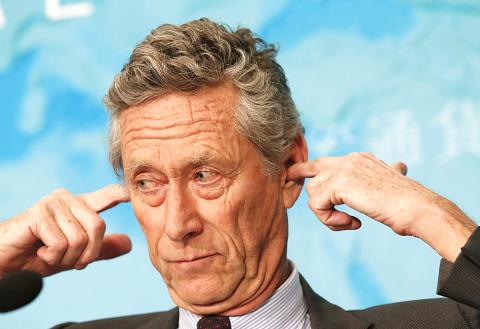The IMF made the steepest cut to its global-growth outlook in three years, with diminished expectations almost everywhere except the US more than offsetting the boost to expansion from lower oil prices.
The world economy would grow 3.5 percent this year, down from the 3.8 percent pace projected in October, the IMF said in its quarterly global outlook released late on Monday.
The Washington-based lender also cut its estimate for growth next year to 3.7 percent, compared with 4 percent in October.

Photo: EPA
The weakness, along with prolonged below-target inflation, is challenging policymakers across Europe and Asia to come up with fresh ways to stimulate demand more than six years after the global financial crisis.
Central bankers and government officials, including Bank of England Governor Mark Carney and Bank of Japan Governor Haruhiko Kuroda might talk about options when they convene this week at the World Economic Forum’s annual meeting in Davos, Switzerland.
“The world economy is facing strong and complex cross currents,” IMF chief economist Olivier Blanchard said in the text of remarks at a press briefing yesterday in Beijing. “On the one hand, major economies are benefiting from the decline in the price of oil. On the other, in many parts of the world, lower long-run prospects adversely affect demand, resulting in a strong undertow.”
The IMF cut its outlook for consumer-price gains in advanced economies almost in half to 1 percent for this year. Developing economies would see inflation this year of 5.7 percent, a 0.1 percentage point markup from October’s projections, the fund said.
The growth forecast reduction was the biggest since January 2012, when the fund lowered its estimate for expansion that year to 3.3 percent from 4 percent amid forecasts of a recession in Europe.
The IMF marked down estimates for this year for places including the eurozone, Japan, China and Latin America. The deepest reductions were in places suffering from crises, such as Russia, or for oil exporters, including Saudi Arabia.
IMF Managing Director Christine Lagarde outlined the sobering outlook in her first speech of the year last week, saying that oil prices and US growth “are not a cure for deep-seated weaknesses elsewhere.”
The US is the exception. The IMF upgraded its forecast for the world’s largest economy to 3.6 percent growth for this year, up from 3.1 percent in October.
Cheap oil, more moderate fiscal tightening and still-loose monetary policy would offset the effects of a gradual increase in interest rates and the curb on exports from a stronger dollar, the fund said.
In Europe, weaker investment would overshadow the benefits of low oil prices, a cheaper currency and the European Central Bank’s anticipated move to expand monetary stimulus by buying sovereign bonds, the IMF said.
The fund lowered its forecast for the 19-nation eurozone to 1.2 percent this year, down from 1.3 percent in October.
The ECB should go “all in” in its bond-buying program, Blanchard said in an interview with Bloomberg TV.
“We want to make sure that when there’s an announcement, that it’s as large as what the market’s expecting,” he said.
The IMF also trimmed its estimate for China’s growth to 6.8 percent, down 0.3 percentage point from October.

TEMPORARY TRUCE: China has made concessions to ease rare earth trade controls, among others, while Washington holds fire on a 100% tariff on all Chinese goods China is effectively suspending implementation of additional export controls on rare earth metals and terminating investigations targeting US companies in the semiconductor supply chain, the White House announced. The White House on Saturday issued a fact sheet outlining some details of the trade pact agreed to earlier in the week by US President Donald Trump and Chinese President Xi Jinping (習近平) that aimed to ease tensions between the world’s two largest economies. Under the deal, China is to issue general licenses valid for exports of rare earths, gallium, germanium, antimony and graphite “for the benefit of US end users and their suppliers

Dutch chipmaker Nexperia BV’s China unit yesterday said that it had established sufficient inventories of finished goods and works-in-progress, and that its supply chain remained secure and stable after its parent halted wafer supplies. The Dutch company suspended supplies of wafers to its Chinese assembly plant a week ago, calling it “a direct consequence of the local management’s recent failure to comply with the agreed contractual payment terms,” Reuters reported on Friday last week. Its China unit called Nexperia’s suspension “unilateral” and “extremely irresponsible,” adding that the Dutch parent’s claim about contractual payment was “misleading and highly deceptive,” according to a statement

The Chinese government has issued guidance requiring new data center projects that have received any state funds to only use domestically made artificial intelligence (AI) chips, two sources familiar with the matter told Reuters. In recent weeks, Chinese regulatory authorities have ordered such data centers that are less than 30 percent complete to remove all installed foreign chips, or cancel plans to purchase them, while projects in a more advanced stage would be decided on a case-by-case basis, the sources said. The move could represent one of China’s most aggressive steps yet to eliminate foreign technology from its critical infrastructure amid a

Nissan Motor Co has agreed to sell its global headquarters in Yokohama for ¥97 billion (US$630 million) to a group sponsored by Taiwanese autoparts maker Minth Group (敏實集團), as the struggling automaker seeks to shore up its financial position. The acquisition is led by a special purchase company managed by KJR Management Ltd, a Japanese real-estate unit of private equity giant KKR & Co, people familiar with the matter said. KJR said it would act as asset manager together with Mizuho Real Estate Management Co. Nissan is undergoing a broad cost-cutting campaign by eliminating jobs and shuttering plants as it grapples